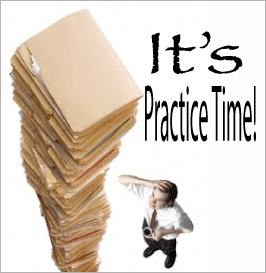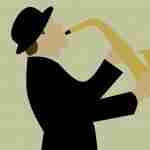Learning to improvise is a life long pursuit. Constantly, we’re bombarded with information on how to improve. From the teachers that give us private lessons, to friends who recommend their personal practice routines, it seems there is improvement information coming from every direction! We’ll even purchase expensive books and videos, searching for “the secret” (that must exist, right?) to improving as an improviser.
With all of these “authorities” and methods on the correct way to improvise, it can be difficult to ascertain what actually works. Everyone has their own style of learning, so naturally, there isn’t one method that works for all musicians. Rather than searching for the best way to acquire information, it can be more effective to filter out what doesn’t work.
Hindsight is 20/20. Looking back at the way I learned to improvise, there is pivotal advice I wish I had followed and certain methods I should have avoided, had I known better.
Here are six common mistakes I made in learning to improvise that you don’t have to make:
1. Learning tunes out of a Real Book
For years, when I would want to learn a tune, I would immediately grab my real book and look up the melody and chord changes. This made sense to me at the time because the information I needed was right there on the page. I learned nearly every song this way. Consequently, on gigs I would depend solely on the real book to get through a set. Even though teachers would tell me to learn by ear and other musicians would say “Throw away your realbook!”, it just seemed easier to read the notes and chord changes off of a piece of paper.
Although it seems quicker at first to get the music from a book, in the long run, the drawbacks greatly outweigh the positives. When you look at a page to learn a standard, you’re leaving your ears out altogether; in other words, training yourself to take in music through your eyes.
The best way to learn standards is from the record – period. This will become apparent after learning a few songs by ear. Each time, the process will become much easier and you’ll internalize the song from the beginning. Today, the standards that I recall without fail are the ones that I’ve learned by ear, straight from the records with my horn in hand.
Learning tunes aurally not only benefits memorization and retention, but is also great ear training. The key is to start learning from the records right away. Remember, once you use the real book as a crutch, you’ll be attached to it wherever you go.
2. Ignoring the importance of ear training
Ear training for me used to mean being able to identify intervals, for example, hearing two successive notes and saying “perfect 4th, tri-tone, etc.” Since I was able to identify the intervals, I thought I had accomplished enough with my ears and moved onto other skills during my practice time. The result: as my harmonic knowledge and technique improved, my ears remained at the same level.
While identifying intervals is useful to know, it is only the tip of the iceberg. If there is one skill that is absolutely necessary to jazz musicians, it is the ability to hear and sing intervals, lines, and chord progressions. Daily ear training will greatly benefit your ability to hear lines and figure out chord changes when you transcribe or learn tunes.
3. Buying books of transcribed solos
As I was learning to improvise I would get books of transcriptions from Clifford Brown, Lee Morgan, and even Michael Brecker. After trying to work on page after page of difficult lines and phrases, I quickly gave up because the lines in the book didn’t look like what was coming from the records.
Buying books of transcribed solos is equally useless as buying realbooks, so save your money! Jazz is a language and the reason you transcribe is to get pieces of this language in the hope that one day you’ll be able to speak it fluently.
You wouldn’t get a book written entirely in French and expect to learn how to speak French, so why would you buy a book of complex solos to learn the jazz language? Just like the words printed on the page of a book, musical notes on a page, are symbols that represent sound, inflection, time, and meaning. Without sound, those ink marks are just approximations.
The only way to get these details and build your vocabulary is to transcribe the lines yourself. By taking one phrase at a time, hearing it and repeating it over and over, these pieces will become your own. Gradually, you’ll have the right tools to use when you’re playing.
4. Trying to learn everything at once
When we start to learn to improvise, there is so much information to absorb that it quickly becomes overwhelming. In my own effort to catch up, I tried to learn everything at once every time I went into the practice room. Everyday I struggled to learn tunes, transcribe solos, work out lines, and practice technical exercises, and more! By trying to cram all that information in as fast as I could, I ended up learning nothing and stressing myself out.
Rather than trying to learn 3 tunes at once or trying to transcribe an entire solo in one sitting, focus on internalizing one small thing at a time and master it. Take the melody of a simple standard or one line of a solo and ingrain every aspect of it into your playing. By reducing your scope and increasing your depth, you’ll retain what you practice, instead of overloading your mind and retaining nothing.
5. Practicing without a plan
As I was developing as an improviser, I had plenty of motivation to practice and no problem getting into the practice room. The only problem was my concept of “practicing.” As long as I was in a room and playing my instrument, I felt that I was accomplishing something.
One thing that wastes more time than anything else is aimless practicing. It’s very easy to get into the habit of just playing exercises or lines that you are good at in the practice room, but it takes real discipline to focus on areas of your playing that need improvement.
When you get into the practice room, know exactly what you want to achieve and how you’re going to do it. Make a list of goals for your daily practice sessions and be sure to cover all of them before you leave the practice room.
6. Looking for shortcuts in books,videos, and equipment
It can be tempting to look for short cuts that will make you instantly better. There are books that claim to teach you extreme high range on the trumpet, mouthpieces that say they will make you sound like Coltrane, and even videos that allegedly will teach you bebop in no time!
Just like learning to run long distances or speaking a new language, there is no substitute for hard work and dedicated practice. As the saying goes, a shortcut is the longest distance between two point.
I wish someone had shared these 6 points with me ten years ago. I’m sharing them with you today, with the hope that I can save you time, money, and years of frustration.
















